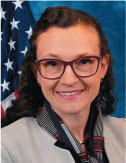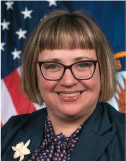In the January 2023 issue of CMSA Today, we described the deployment of a regional, competency-based educational strategy designed to drive systemwide case management integration efforts within the Veterans Health Administration (VHA) Western States Network Consortium. The WSNC is a broad region that covers 18 states, which house a total of 38 VHA facilities across the western United States. After a year of training more than 1,000 social work and nurse case managers, a comprehensive, six-month post survey is being administered to evaluate the impact of the training on the larger VHA integrated case management implementation efforts.
The seven-and-a-half-hour virtual training program launched in October 2022 and is taught by experienced WSNC registered nurse and social work leads. The curriculum focused on case management standards of practice, ethics, social determinants of health, predictive analytics, assessment of veteran complexity, care coordination review team and case management roles and responsibilities.
The original curriculum was delivered via a monthly virtual, facilitator-led session. The format was restructured to maximize access to front-line care coordinators across five time zones. The adapted curriculum maintained all the content but shifted half of the sessions to a virtual, pre-recorded, self-paced format with the remaining four-hour facilitator-led portions scheduled four times monthly. The training was promoted to WSNC facilities as an approach to address their care coordination and integrated case management education plan (a standardized document required of each VHA facility as a part of care coordination and integrated case management implementation) and to drive the provision of standardized, high-quality integrated care management services across systems and program areas.
BACKGROUND: CURRICULUM STRUCTURE
The WSNC training curriculum aligned with RACETIME: the VHA operational framework for integrated case management (Misiti & Risinger, 2020). The “R” signifies Risk stratification, “A”: Assessment of complexity and “C”: Care coordination lead. The training leads with contextualizing these three concepts, which enhance traditional case management practice.
Additionally, the “E to the E” in RACETIME represent the quality and value that case management brings to the patients and align with the Case Management Society of America Standards of Practice for Case Management (2022). These include Evaluating whole health needs, Trusting partnerships (between veteran client and case manager), Integrating care, Monitoring veteran progress and Experience of veteran and employee. A core principle of RACETIME is that systemwide case management improvement is driven by the development of front-line staff competency in new skills such as the utilization of predictive analytic tools and clinical dashboards as well as adoption of a standardized approach to complexity. The enhancement of existing case management practice across program areas to align with VHA and CMSA case management standards of practice functions as a force multiplier to eliminate inefficiencies within existing systems and improve the direct patient experience by matching veterans with the right level of care at the right time.
WSNC CCICM AND PROSCI CHANGE MANAGEMENT: INFUSING KNOWLEDGE AND ABILITY
The curriculum structure was also informed by Prosci Change Management research. Systemwide care coordination and integrated case management implementation steps intentionally align with the Prosci Change Management and ADKAR (awareness, desire, knowledge, ability and reinforcement) models of practice. The guiding principle in each module was that before case managers could demonstrate the ability to support broader efforts to improve case management practice, it was crucial to cultivate awareness of why the change was happening, connect them to the value of change and provide the knowledge of how to become part of this change (Danielson et al., 2020; Prosci, 2020).
SIX-MONTH POST-COURSE EVALUATION
After completing the program, the participants were prompted to complete an initial course survey to access the seven-and-a-half continuing education units. A total of 688 participants completed the survey. Participants were highly satisfied with the training, with an overall mean across five items of 4.25 (on a 5-point scale). Results demonstrated that the participants learned the content and skills and accomplished the eight learning objectives with mean scores of 4.26 and 4.20 (on a 5-point scale), respectively.
In partnership with a VHA Institute for Learning, Education and Development (ILEAD) measurement consultant, a comprehensive six-month post survey was developed to determine if the participants applied their knowledge and abilities to their daily work of providing high-quality case management services to veterans. The questions were designed to determine if the training curriculum positively impacted participants’ practices on the job as it relates to CCICM.
The six-month post survey also measured systemwide “enablers” and “barriers” to the application of skills to understand factors facilitating implementation of CCICM and account for external risks that are adversely impacting the expected results.
Six months after the completion of the course, 362 participants were sent a link to a voluntary and anonymous survey housed in a web-based application called Qualtrics. Participants were informed their feedback would be used to improve the training for future cohorts. The survey included 21 questions and took seven to nine minutes to complete. Approximately half of the total participants completing this training have had the opportunity to complete the survey; data collection is continuing through March 2024. Thus far, we have received 79 responses: 57% (45) nurses, 39% (31) social workers and 4% (3) other (e.g., physicians).
ENABLERS AND BARRIERS
Prosci Change Management identifies employee engagement and middle manager engagement as enablers essential to the success of any change project (Danielson et al. 2020, p. 23). Additionally, Prosci’s ADKAR Model recognizes that five elements must be present for a change effort to be successful: awareness, desire, knowledge, ability and reinforcement. The presence of a barrier in any of these elements can impede the change process (Prosci, 2020).
The top four “enablers” identified in the six-month post evaluation were employee motivation 69% (44), managers 64% (41), ability 61% (39) and knowledge 61% (39). These results reflect a cohort of care coordinators and their managers who are driven to improve their practice with the knowledge and ability to accomplish this goal.
The top four “barriers” were none 52% (31), time 22% (13), other 13% (8) (e.g., not applicable to position at this time) and resources 12% (7).
These results are promising, suggesting a presence of a high level of front-line staff engagement with manager support as well as the knowledge and ability to implement the change in practice at each facility. The identified barriers were minimal (time and resources) and could be addressed through mitigation strategies developed at the local healthcare system.
CONNECTING THE VALUE OF EDUCATION TO CCICM IMPLEMENTATION AND CHANGE MANAGEMENT
Approximately four out of five respondents reported that they were “often” or “always” applying the standards of case management six months after training. The social work and nursing case managers developed a standardized ethical practice that promoted their shared professional identity that was grounded in the CMSA Standards of Practice for Case Management (2020), the CCMC Code of Professional Conduct for Case Managers (2018) and the VHA Integrated Case Management Standards of Practice (2020). However, only 15% of respondents were certified in case management, identifying an opportunity for consortiumwide future strategic planning.
Since completing the training, well over half of the respondents (59%-76%) used clinical dashboards, predictive analytic tools and/or the CCICM Complexity Assessment Tool (an internally developed VHA tool). Approximately a third of the respondents indicated that they or a team member had referred a veteran to a care coordination review team based upon predictive analytics. This finding suggests that the participants transformed their knowledge of risk stratification and assessment of complexity into operational abilities to improve patient care through proactive identification and an assessment of the veteran’s need for a customized care plan.
Almost all (90%) respondents were “often” or “always” collaborating with veterans’ care teams to create a unified treatment plan. Of the various available resources, respondents were most frequently assessing veterans for referrals to mental health resources, specialty/medical care, transportation resources and nutrition/food security within and outside of the VA.
These findings were especially exciting as they addressed foundational elements of the VHA operational framework RACETIME: E: Evaluating whole health, T: Trusting partnerships and I: Integrating care.
The six-month post survey identified that respondents were frequently monitoring patient goals and outcomes via the electronic health record documentation and actively engaging in transitions of veteran care (mean scores of 3.12 and 2.90 [on a 4-point scale], respectively). This response indicates that participants in the WSNC training developed the RACETIME skills of M: Monitoring veteran progress.
WSNC remains committed to providing support to facility leaders and case managers across a large region through a centralized, accessible training option. The results of the six-month post survey suggest that competency-based education focused on standards of practice is a successful strategy to reinforce local integrated case management efforts. This popular offering has been renewed for a second year with a commitment to build a care coordination community across the western states that is grounded in the RACETIME framework, VHA 1110.04: VHA Integrated Case Management Standards of Practice (2020) and the CMSA Standards of Practice for Case Management (2022).
REFERENCES
Case Management Society of America. (2022). Standards of Practice for Case Management. https://cmsa.org/sop22/.
Commission for Case Manager Certification. (2018). Code of Professional Conduct for Case Managers. https://ccmcertification.org/sites/ccmc/files/docs/2022/CCMC-22-Code-Of-Conduct-Update-Final%20with%20CM%20def%20update.pdf.
Danielson, R., Davis, M., FitzSimons, A., Flood, M., Ganvick, K., Garside, J., Hazelton, E., Grossman, R., Jacob, JD., Lehman, T., Marzana, R., Schultz, C., Stise, R., & Thomas, A. (2020). Best Practices in Change Management 11th Edition, Prosci Inc.
Misiti, R., & Risinger, A. (2020, July 23). RACETIME: an organizational care coordination approach to improving patient outcomes in a complex healthcare setting. [Conference Presentation]. Military Social Work & Behavioral Health Conference, Austin, Texas, United States. https://sites.utexas.edu/military-social-work-conference/misiti-risinger.
Prosci (2020), Prosci change management practitioner program [Course Presentation]. Prosci Inc.
United States Department of Veterans Affairs. Veterans Health Administration. (2020). Integrated Case Management Standards of Practice (VHA Directive 1110.04(1)).








